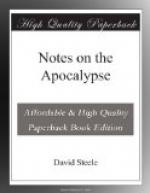6. And I beheld, and, lo, in the midst of the throne and of the four beasts, and in the midst of the elders, stood a Lamb as it had been slain, having seven horns and seven eyes, which are the seven Spirits of God sent forth into all the earth.
V. 6.—In this verse we have the Lord Jesus Christ introduced to the view of John and the intelligent universe in his sacerdotal or priestly office, “a lamb, as it had been slain.” In the order of nature and of merit, his priestly office precedes his prophetical and kingly offices. This is evident from the position which he occupies in relation to the throne and royal retinue. He stands in the attitude of a priest “in the midst of the throne and of the four animals,” etc. As seen here, our Saviour does not sit on the throne. He appeared in a standing posture. His position was obviously before the throne. As the priestly function required, he stood nearest to the object of worship, between the ministers and the throne,—in the inmost circle. There he exhibited the scars received in war; the wounds made by the sword of divine justice; (Zech. xiii. 7;) the holes in his hands and side by the nails and soldier’s spear. (John xix. 34; xx. 23.) This “Lamb slain,”—typified by all the spotless lambs offered in sacrifice by divine appointment from the time of Abel, had been marvellously restored to life, as no other victim had ever been. (John x. 18; ch. i. 18.) The “seven horns and seven eyes,” symbolize the power and wisdom of the Mediator. “It pleased the Father that in him should all fulness dwell.” (Col. i. 19.) He “giveth not the Spirit by measure unto him.” (John iii. 34; Heb. i. 9.) Christ was privy to all the purposes of his Father, (John v. 20,) and the extent of his knowledge is limited in him as Mediator, only by the authority and will of the Father. “Of that day and that hour ... knoweth no man ... neither the Son.” (Mark xiii. 32.) The same interesting and important truth is taught by the Father’s holding the book in his hand, as also in plain words, (ch. i. 1,)—“the Revelation of Jesus Christ which God gave unto him.” “No man knoweth the Father but the Son.” (Matt. xi. 27.) In office-capacity the Lord Christ is qualified to unfold and execute the decree of God. (Ps. ii. 7,) as more fully appears in the following part of the book.




